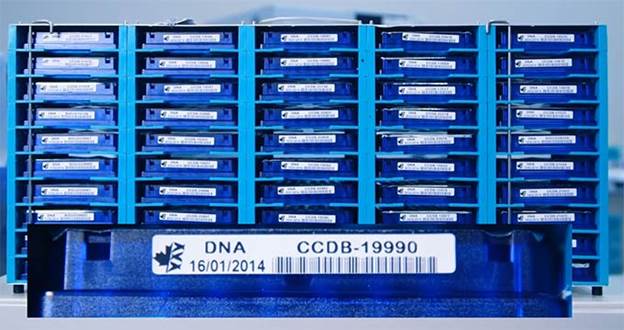By: Logan Calkins and Janet Hetherington
DNA is what makes each person or species unique. It's that double helix that your genes are made of. DNA accounts for why you resemble your parents and it distinguishes you from everybody else.
Now, imagine a world where all discovered species could be identified through DNA processing and sequencing. This is called “barcoding.”
The Canadian Food Inspection Agency (CFIA), along with international and national partners, has been working on just such an initiative. It’s called the Barcode of Life, and it’s being led by the Biodiversity Institute of Ontario. The Institute is situated at the University of Guelph, which just happens to be the birthplace of the use of DNA barcodes.
The Barcode of Life uses a very short genetic sequence of DNA to identify a species similar to the way a barcode is used to identify products at your local grocery store. The mission of DNA barcoding is to ultimately catalogue every living species in the Barcode of Life database.
In January 2016, Canada’s Minister of Health announced a federal government investment to support the Barcode of Life, with the CFIA is contributing $323,000 over 18 months to support scientific collaboration with the Biodiversity Institute of Ontario, University of Guelph.
There is a very practical reason why the CFIA has a vested interest in this initiative, and it has to do with stopping unwanted plant pests and preventing fish labelling fraud. The goal is to develop DNA barcoding capacity in Canada. Ultimately, the CFIA will be able to identify invasive pests that threaten Canadian agriculture and forests faster than before. The Agency will also be equipped to more easily identify species for sale that may have been misrepresented, such as fish and seafood.
Access to the Barcode of Life would help with verifying any given species’ DNA and assist the CFIA with its regulatory enforcement activities.
"This technology is an absolute game changer," says Cameron Duff, Executive Director of the CFIA’s Plant Health Science Directorate.

Stacked DNA trays with barcode stickers labelling each separate species
The CFIA is dedicated to safeguarding plants, animals and food. Plants are the first link in our food chain, and they are critical to Canada's economy. The country’s crop industry generates more than $22 billion in exports alone.
Unwanted invasive pests can cause extensive damage to Canada's crops and forests. The problem is, many plant pests – such as hungry bugs and the eggs they lay – can look alike. Right now, specimens are most commonly identified visually, by looking at their shape, size and colour.
DNA barcoding offers a more accurate identification method to complement traditional techniques. This can lead to a more rapid identification of those plant pests. The ability to accurately detect and identify species using this technology is key to protecting Canada’s agriculture, forests and food supply.
“Rather than having to send an egg mass to an entomology lab, which could take months to get the egg mass to a stage where it could be identified, DNA barcoding could compress the process down to days,” says Mr. Duff.
CFIA research scientist Dr. Delano James agrees. "I think this is a very powerful technology that could allow the identification of a potentially harmful insect pest without needing a fully developed or intact specimen," he says.
The CFIA would benefit from a more efficient way of identifying invasive species to prevent the entry of pests in Canada. This would lead to great advances in the surveillance and risk management programs that the Agency delivers.
Invasive species are most commonly spread by cross-border movement of products. DNA barcoding could set more reliable practices for regulators when determining the presence of species that pose a risk.
It could also help with compliance. Consumers need accurate labelling information so they can make informed decisions about the food they are buying. For example, when the label on a package says “cod,” the fish inside should be cod. The CFIA also sees how this technology will help with the identification of other species so that the label matches the contents, which can be difficult for fish and seafood products.
Trade, too, would benefit. When there is a quick and certain identification of a species, trading partners are better able to agree upon regulatory approaches required. One challenge stems from the consistency of species identification among trading partners. Some species are closely related, and difficult to identify or distinguish. If misidentification occurs, it can lead to differences in regulatory approach.
Employees across the CFIA's laboratory network are working together to develop and test the technology. Projects such as the Genomics Research & Development Initiative, Quarantine and Invasive Species project, and the Genomic Applications Partnership Program, have all contributed to improving existing methods and giving new capacity to speed up species identification processes.
Along with the Biodiversity Institute of Ontario, CFIA employees have also connected with such federal partners as Agriculture and Agri-Food Canada and the Canadian Forest Service, as well as international partners. The goal is to obtain as much data as possible from across the globe, including areas such as Africa, Asia, Europe, the Pacific Region, North and South America – with all partners working towards international integration and adoption.

Access to the Barcode of Life would help with verifying any given species’ DNA and assist the CFIA with its regulatory enforcement activities.
